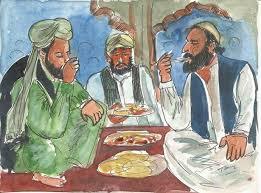HISTORY OF MUGLAI CUISINE
This type of Indian cuisine originated in northern India in places such as Uttar Pradesh, Delhi, and also among Muhajir ex-pats in Pakistan. Traces of Mughlai cuisine can also be found in the Indian cities of Bhopal and Hyderabad were Central Asian cuisine largely influenced its flavours. The official language of the Mughal Empire was Persian, so many Mughlai dishes also have Persian and Turkic names. Once prepared for royals and emperors, these dishes feature flavorful meals that combine the traditional spices and flavours that embodied Indian cuisine.
Some of the Muslim-influenced names in Mughlai dishes include biryani, pulao, kebabs, and kofta. The strong influence of Muslim cooking styles is evident throughout Mughlai meals as Mughals left a lasting impact on India. This is evident as Mughlai dishes are still very common and desired today.
COOKING
The preparation of Mughlai cuisine was likely time-consuming and very involved with the number of flavoured sauces and butter-based curries it's almost like it was created to make people want more food because it can be that indulgent! The names of these foods are also so intriguing, which may tempt people to try new dishes in the Mughlai style. Because the Mughals were Muslim and Hindus by religion, pork and beef are traditionally not a part of this cuisine and instead heavily consumed and used goat, fowls, sheep, and venison in addition to vegetarian-based dishes.
 Most Indian restaurants interpret Mughlai dishes as mild to medium-hot cream and nut-based gravies, rice dishes with lots of nuts, dried fruits, and rich creamy desserts where you should expect spices like saffron, cinnamon, cardamom, cloves, and nutmeg. These popular Mughlai-style gravies also pair well with rice and bread.
Most Indian restaurants interpret Mughlai dishes as mild to medium-hot cream and nut-based gravies, rice dishes with lots of nuts, dried fruits, and rich creamy desserts where you should expect spices like saffron, cinnamon, cardamom, cloves, and nutmeg. These popular Mughlai-style gravies also pair well with rice and bread.
Common dishes that feature traditional Mughlai flavours include biryani, kebabs, kofta (meatballs), pulao (or pilaf), and tandoor. Examples of these traditional dishes include Mughlai chicken, Mughlai biryani, Mughlai paratha, malai kofta, reshmi kebab, kadhai gosht, and murg tandoor. Traditional Mughlai desserts include the bread pudding Shani tukra, barfi, kalakand, and falooda.
Though many Mughlai meals are rich, decadent and savoury, they can always be lightened up by substituting healthier ingredients. With its historical roots, Mughlai cuisine is still very much alive in kitchens across the globe, whether at home or in restaurants.
RECIPE OF THE DAY
MUGLAI PARATHA
INGREDIENT
· 3 Cups whole wheat flour
· 1 cup all-purpose flour
· 2 tbsp ghee
· 2 cups water (for the dough)
· Dry flour (for rolling)
· Ghee (for frying)
· 4 Eggs
· to taste salt
· 1/2 cup onions, finely chopped
· to taste green chillies, chopped
· 4 tbsp coriander leaves, chopped
METHOD
1. Mix the whole-wheat flour, refined flour and the two tablespoons of ghee together.
2. Knead into a soft, sticky dough and cover and leave aside for 2-3 hours.
3. Divide the dough into 4 rounds, cover and leave to rest for about 15 minutes.
4. Heat a griddle over the stove. While it is getting hot, roll out one round.
5. The dough is sticky and soft, so you may need to dust it with flour frequently. Better still, pat it thinly with your palms if you can.
6. Keeping the heat on high, place the roti over the griddle, break an egg on to the centre of it, sprinkle with 2 tsp of onion, salt, green chillies and 1 tbsp of coriander leaves.
7. Lower heat to medium. To seal, fold over four ways towards the centre, so that the ends overlap, thus forming a square.
8. Make a trail of ghee around it to fry the underside.
9. When the underside is fried, smear the top with a generous helping of ghee and turn over to fry to a golden brown.
10. Serve hot with a chutney or yoghurt.
Email- vanshakuniyal@gmail.com
Instagram- https://www.instagram.com/_bhojnam/
















